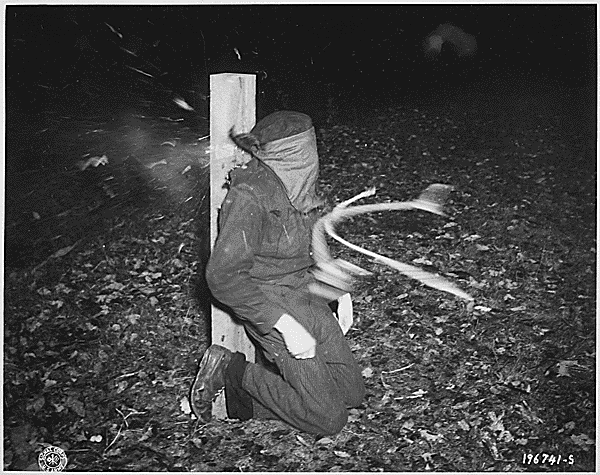Retribution: The Punishment of Nazis Collaborators

French firing squad hit a Frenchman who collaborated with the Germans. This execution took place in Rennes, France.
The war was over, and in the period immediately after the war, many of those who collaborated with the Nazis faced retribution. That retribution varied greatly from country to country.
The end of the war brought a period of retribution against those who had started the war and those who had collaborated with the Nazis. In France, it is estimated that the resistance and their followers executed 10,000 people. One-third of them were killed before Allied troops landed at Normandy. In Italy, it is estimated that as many as 15,000 were killed in rounds of retribution. In Belgium, 250 were executed, and in the Netherlands, less than 100 met this fate.
Accusations against women for collaborating were widespread, and the term "collaboration horizontale" was used. In the Netherland, the woman was tarred and feathered; in France, they were stripped naked, shaved, and displayed in the town square.
In Eastern Europe, the numbers killed are unknown but are believed to run in the many thousands.
These were extrajudicial actions, but legal steps were taken against the collaborators with the war over. In Norway17,000 men and women were convicted of collaboration and sent to prison, and 30 people were sentenced to death; 25 of the sentences were carried out. In the Netherlands, the Government investigated 200,000 people, and nearly 100,000 were imprisoned for collaboration. 17,500 Civil servants lost their jobs, and 154 people were sentenced to death, with forty people being executed. In Belgium, approximately 100,000 were imprisoned, and 2,490 death sentences were handed out. Two hundred forty-two people in Belgium were executed. In the Netherland, most of those detained were quickly amnestied, while those in Belgium served longer sentences.
France was different than the above nations. Frances's Government, the Vichy government, was itself a collaborator while the above countries' governments had gone into exile and led opposition to the Nazis from abroad. Therefore the French had a more challenging time coming to grips with handling collaborators. France, with a much larger population than the Netherlands, Norway, or Belgium, imprisoned 38,000 for collaboration, of which most received amnesty in 18947 and all but 1,500 received amnesty in 1951. 6753 French were sentenced to death, half in absentia, 791 were put to death. None of the french were accused of crimes against humanity for their role in the Holocaust; instead, most were charged with "national degradation."
Determining who should be punished was acute in Italy. The Government had changed sides in 1943. Three hundred ninety-four thousand government employees were investigated, but only 1,580 were dismissed from government employment. Most were able to get their jobs back. 55 people were executed for their actions
In Czechoslovakia, Extraordinary People courts sentenced 713 to death, 741 to life sentences, and 19,888 to shorter prison terms. In Hungary and Yugoslavia, similar judicial punishment was handed out for collaboration.
Austria was a unique and, in some ways, baffling case. The Allies had agreed in 1943 to define Austria as the first victim of Nazis Germany. This was a convenient way to center all of the blame for the war on Germany. However, it did ignore the fact that in a country of 7 million, there were 700,000 members of the Nazis party. In addition, 1.2 million Austrians had served in the German army, and a high proportion of the Austrian served in the SS and as concentration camp administers. An illustrative fact is that 45 out of the 117 members of the Vienna Philamarnic were members of the Nazis Party, while in Berlin, only eight of the 117members were members of the party.
Thus despite being declared the first victim of the Nazis, many people were guilty of the Nazis' crimes in Austria. 130,000 Austrians were investigated for war crimes, 23,000 were tried, and 13,600 were found guilty. Forty-three people were condemned to death, but only 30 were executed. There was an attempt to denazify both the civil service and the education system . 70,000 civil servants were dismissed, including 2,943 elementary school teachers and 477 high school teachers. In 1947 the Austrians passed a law differentiating between bigger and lesser Nazis. Five hundred thousand people who fit the description of lesser were amnestied in 1948, and the balance of about 42,000 received full amnesty in 1956.
 >
>